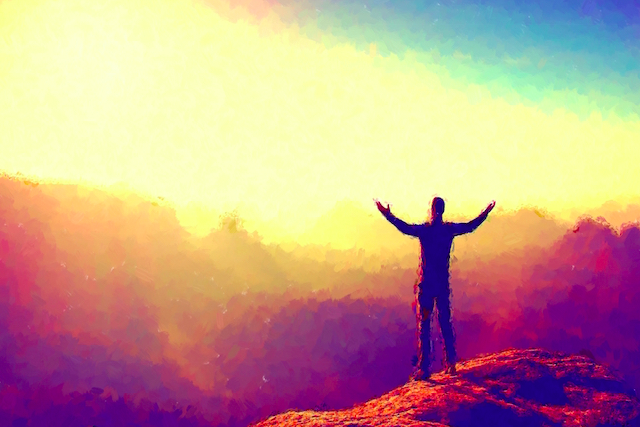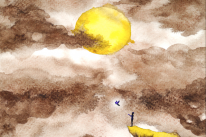
“Our way to practice is one step at a time, one breath at a time.” ~Shunryu Suzuki
Sitting meditation has always been challenging for me; practicing mindfulness, even harder.
As a self-confessed worrywart who has contended with constant ruminations, flashbacks, and nightmares for most of my life (more on this later), all prior attempts at being fully present and not thinking merely served as reminders of how little control I had over my mind. Then I took up hiking and stumbled upon a form of meditation that literally transformed my life.
Initially, just being out in nature on scenic trails cultivated calmness and cleared my head. Almost immediately, I realized that hiking provided a respite from intrusive thoughts that have plagued me since I was a tyke.
They include flashbacks of my mother’s numerous suicide attempts in our decrepit Chinatown apartment, my father’s drunken rages, and recurring images of shootings, savage beatings, and other gory crime scenes from my gangbanging days.
Ruminations include the sound of gunfire along with the replaying in my head of toxic utterances in Cantonese that translate to “Giving birth to you was my biggest mistake,” “I wish you were never born,” and my own father yelling “You bastard!”
Somehow, walking in nature enabled my mind to slow down and rest, which felt liberating.
Unfortunately, the novelty soon wore out. Merely walking and hiking wasn’t enough to prevent symptoms associated with post-traumatic stress from returning. I reverted to rehashing the past and worrying obsessively about the future.
However, I had gotten a taste of the benefits of mindfulness meditation and discovered that it can be practiced while engaging in an activity I enjoyed. These revelations motivated me to keep at it.
After reading what was available on walking meditation, which typically advise focusing on the flow of our “in” and “out” breaths, I developed my own techniques for practicing mindful walking and hiking.
My favorite is to look ahead and select a destination point or object and stay focused on it. It can be a shadow on the ground, boulder, bush, tree, manhole cover, light pole, store awning, mailbox, and so on. Once I reached it, I chose another landmark or object, usually a little further away.
Rough or uneven trails forced me to concentrate on each step for safety reasons. My brain automatically blocked out discursive thoughts; otherwise I could slip, trip, or fall. Other techniques I came up with include fully feeling the ground of each step, following the flight pattern of birds and insects, observing cloud patterns, and being conscious of sounds and scents—moment to moment.
Zen monk Thich Nhat Hanh, often called “Thay,” which means “teacher” in Vietnamese, is revered throughout the world for his teachings and writings on mindfulness and peace.
He has brought the practice into institutions, including maximum-security prisons, helping inmates attain calmness and inner peace while being confined up to twenty-four hours daily. Many of them have professed that mindfulness meditation is the most difficult endeavor they have ever engaged in.
We live in a culture where many of us want quick results with as little effort as possible. This applies to how we approach our work, health, pastimes, social interactions, and problems. This mindset is the antithesis of mindfulness.
In my opinion, it is virtually impossible to tackle mindfulness meditation without patience and discipline. Fortunately, these attributes can be enhanced by engaging in the art itself.
When I started mindful walking and hiking, my ability to stay present was measured in feet and seconds.
As a highly competitive, emotionally undisciplined, and impatient person, I could have easily succumbed to my frustrations and given up. But the short periods of calmness and inner peace I attained—supplemented by my stubbornness—provided the necessary resolve for me to stick with the program.
As I continued my mindfulness “training,” catching my mind when it wandered occurred sooner, and the ability to refocus took less effort. Using kind, positive messages such as “rest” and “focus” was more effective than phrases such as “don’t wander” and “don’t think.”
Insight and mindfulness meditation are usually practiced separately. Personally, when I am procrastinating about something or seeking a solution to a problem, ideas and answers usually emerge effortlessly during or immediately following my walks and hikes.
These epiphanies and aha moments tend to be inspired by kindness and compassion, as opposed to ego.
I was severely beaten by a rival gang member as a teen. For over forty years, I suffered nightmares, flashbacks, and ruminations of the attack. Both conventional and unconventional modalities of therapy failed to provide much relief.
One morning, I was enjoying a relaxing hike when the familiar image of my attacker suddenly appeared. For the very first time, I remained calm and found myself viewing my lifelong enemy as a kindred spirit. I saw him as someone like me, most likely abused as a child, who desperately sought empowerment by joining gangs.
This awakening, along with my spiritual practice, enabled me to cultivate compassion and forgiveness. The nightmares and flashes of the attack ceased at that point and have not returned.
Mindfulness can be practiced pretty much anywhere and at any time. I do it first thing in the morning when I wake up while still lying in bed, in the kitchen, in the shower, at my desk, and most recently while getting dental work done.
Whether I devote a few seconds by pausing and taking a deep belly breath—or hiking for several hours—benefits are reaped.
As I mentioned at the beginning of this post, practicing mindfulness has transformed my life. With a family history of mental illness and a violent upbringing, I have been diagnosed and treated for multiple mood disorders, including manic depression, post-traumatic stress, addiction, and rage.
My mindfulness practice has empowered me to rest and calm my mind, as well as intercept and suppress negative thoughts. It serves as a powerful coping mechanism for me.
For the majority of my life, I was at the mercy of gambling urges and other cravings. When I encounter them now, I pause, acknowledge what is happening, take a few deep breaths, focus on my surroundings, and allow the urges to pass.
Staying relaxed enables me to respond instead of react, which places me in a better position to reflect and gain insight into the underlying issues that triggered the desire to self-medicate.
My mood is much more stable and I have better control of my emotions. The benefits I received from mindful walking and hiking has inspired me to practice it throughout the day.
I used to loathe driving because of my road rage. I was terrified of myself, often wondering when I left the house if I would end up in jail or the morgue. My level of stress rose in proportion to the amount of traffic I encountered.
Practicing mindfulness meditation in the car keeps me mellow as well as alert. I have become a patient and compassionate driver, smiling at other motorists and limiting use of the horn for safety purposes. Another insight I gained is that my past aggressive behavior on and off the road attracted like-minded people.
The mental discipline I gained also enabled me to embrace Buddhism, which has interested, yet eluded me for many years. All of this empowers me to attain and maintain equanimity. Now, I can even sit and meditate for long periods without feeling restless or irritable.
So for those who find sitting meditation challenging, or for individuals seeking different ways to practice mindfulness, I recommend mindful walking and hiking.
Not only is it a fun way to quiet the mind while getting some exercise, but it can be life-changing—helping us let go of worries, stress, tension, and even the most painful memories from the past.
About Bill Lee
Bill Lee is a second-generation Chinese American who grew up in the Chinese underworld. He is the author of three memoirs. In his new book, Born-Again Buddhist: My Path to Living Mindfully and Compassionately with Mood Disorders, he describes in detail the positive impact that mindful walking and hiking has made in his life. Visit facebook.com/Bill.Lee.author.













 Though I run this site, it is not mine. It's ours. It's not about me. It's about us. Your stories and your wisdom are just as meaningful as mine.
Though I run this site, it is not mine. It's ours. It's not about me. It's about us. Your stories and your wisdom are just as meaningful as mine. 